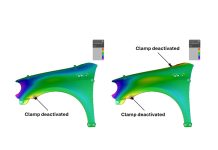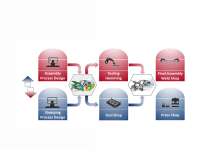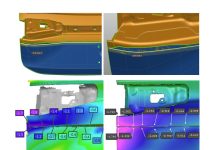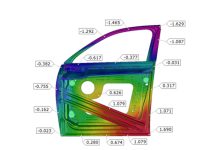[dropcap]I[/dropcap]n this interview, Natàlia Domínguez, Technical Product Manager, and Michael Düring, Product Manager, both from AutoForm share their insights based on their interactions and questions from users of AutoForm-HemPlannerplus.
A huge fan of hiking over rocky-mountains, Natàlia Domínguez has joined this interview as a keen overseer of AutoForm-Quicklink and AutoForm-HemPlannerplus. She played a major role in building a customer network in Brazil, Argentina and Mexico at a time when AutoForm didn’t yet have offices in those locations.
Michael Düring also joins us as the Product Manager for hotforming and hemming solutions at AutoForm. He is a regular contributor to AutoFormingWorld, featuring several articles here on aluminum hotforming and cooling channels.
Q1. Please tell us about AutoForm-HemPlannerplus.
Natàlia started first, ‘While simulation for the creation for each part is important, here in using hemming we now arrive to joining those parts. AutoForm-HemPlannerplus is AutoForm’s hemming solution, which allows users to efficiently plan and optimize that process. Thus at the same time it’s the last process at the end of the part’s creation, making this operation for closures crucial. There are many challenges to overcome in getting to this final process. Finalizing and validating the stamping process through the production of the outer panel with unrolled hem flanges is just one of these. Until now, most of the effort towards engineering and simulation has been invested into the stamping process alone, whereby hemming had received far less in terms of application of similar sophisticated engineering tools.’
Michael joined in saying ‘Traditionally there were connections between the engineering approaches for stamping and hemming processes based only on standards. The standards and rules of thumb were used by experienced members in the organizational structure at the OEM or suppliers site. Nowadays we offer tools which can support intended hemming engineering processes far beyond that and already simultaneously to the (early) feasibility checks, draw-die design, stamping process engineering and design. With the QuickHemming-option – which primarily aims the early detection of typical hemming issues like splits, wrinkles and bad roll-in – we also created a powerful tool for planning purposes.’
Michael continued ‘For instance process times and shop-floor space can be derived from the out-coming data. The systematic refinement of the data input in form of adding pre-deformed inner and outer parts – what is done in our Advanced Hemming solution – gives opportunities for a detail validation of the process. Yet it is clear the success of hemming processes depends on the outcome of all stamping and trimming that was beforehand undertaken, leading up to the hemming operation.’
‘Right’ added Natàlia ‘The goal is to ensure that, both the inner and outer panel, parts are compatible with the hemming process in real and when process design of the trim and flanging ops is carried out. Furthermore, this process heads towards assembly and it may become complex. A door for example consists of several inner parts, all of which are joined entirely/and prior to the hemming process. The definition and calculation of the hemming process considering the complete assembly and starting in early project stages for inner and outer parts is the step forward that AutoForm will address in the near future.’
Q2. So what issues can be critical during the hemming process?
Natàlia continued ‘The ‘fit and finish’ status on a vehicle part is strongly influenced by two major outcomes of the hemming process on individual closure assemblies. The first is surface lows and distortions on Class A surfaces and the second is perceived or ‘apparent’ gaps between the closure panels, or between closure and BIW. The real issue is that the parts may not line up correctly as well. This could be simply due to limitations of the standard based hemming planning or arise from issues and variations affecting earlier forming processes of the part which will now can cause distortions during hemming.’

Michael added ‘The correlated springback of a hemmed set of parts can strongly influence the assembly compatibility for the final car set up. By assessing a subsequent measurement after die, table-top or roll-hemming – including manifold clamping options – the models can deliver valuable hints and indications for process improvements for enhanced real part compatibility.’
‘Then there is the risk of wrinkles’ said Natàlia, saying ‘For instance, when applying a roll hemming process, the rollers may cause the two parts not to overlap correctly, when the process and/or the outer part cut out plan are not planned correctly.’
Now Natàlia explained, ‘Another thing worth pointing out is that some users unfortunately do not yet use the software to its full capabilities. In fact the simulation of hemming operates with a high level of accuracy. This is something that brings customers valuable benefit in their working process. In addition, at AutoForm we are constantly reviewing and improving the working parameters to increase the accuracy of our results.’

Michael mentioned ‘Therefore two of the upfront decisions that need to be made, with a view to successful hemming are, firstly concerns the angle of the hem flange, to which the flange is formed in the stamping line, and secondly the allowance that is applied (‘plussing’) to push out the flange break line, in order to best account for roll-in during hemming. To be sure, these important decisions are not anymore based on strong accumulated experience and with the results that we got with the simulation of the hemming process with AutoForm-HemPlannerplus.’
Q3. What is an interesting question that often comes up?
This was Natàlia’s area: ‘There are a lot of different questions that I usually get from users during the set-up definition of the simulation file because the main interest for the customer is to define a virtual process as close to reality as possible. With AutoForm-HemPlannerplus we have a lot of possibilities to adapt the simulation to reality. Answering simple questions are comprehensively covered by our advanced dedicated training seminars. The software has the capabilities to adapt this calculation into their simulations – which is explained and demonstrated even on-site at the customer. In addition, the modification and test of different combination of parameters is so easy that offers the users the possibility to simulate several and very different set-ups in order to arrive to the optimal and safest definition of the process before to proceed to the real process set up saving the companies an important number of expensive trial and error tests.’
She added ‘We are also in close contact with simulation specialist in order to address their needs for information. So, the point is that as the definitions of hemming improve and adapt, and as customers adapt new method we work this into the software.’
Michael finished our interview, saying ‘AutoForm-HemPlannerplus is just the first step in assembled part simulation. There are still several processes that are not yet highly simulated, and still offer opportunities for the substitution of resource consuming trial and error loops. We look forward to proving further advancements in computing technology so that everyone can have more sophisticated models. The key for AutoForm is in delivering those new models with a maximum ease of use.’
Thank you readers for visiting our blog and a big thank you if you’ve already signed up! If not now is a great time to stay informed about our blog posts. We’ll never send you any marketing emails.













